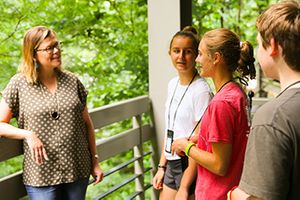
The keynote speaker at Catawba College’s 2017 National Environmental Summit took a slight turn from the event’s theme: Redesigning Our Future.
Heather White, president and CEO of Yellowstone Forever, the nonprofit partner of Yellowstone National Park, told the high school students Tuesday night to spend time being deliberate and thinking about a vision for their future. “Redesigning our future is what we need to do collectively,” she said, “but how can you design your own future?”
She outlined three elements in that individual design:
- Conduct informational interviews. “Talk to people,” she said. “Gather information. Collect stories. Meet with people who are doing the things you think are interesting.”
- Write it down. “All the research says if you write down what your vision is and where you want to go, the chances of achieving it are much, much higher.”
- Have faith in yourself. “You have more knowledge right now than any other generation that has ever walked the earth, from physics to math to technology to health to environmental science,” she said. “You have the power to create the solutions that we need, to address all of these really difficult environmental problems.”
White noted that they will have many opportunities but with opportunity comes responsibility. “Think of all the people who came before you to create the opportunities you have now,” she said. “Honor them by making a difference.”
Connections with people are critical to success, according to White. She encouraged the teens to seek help from others. “Jobs are all about people. It’s not a computer; it’s not an algorithm that’s going to get your job. It’s people.”
Mentors are happy to help, White said: “The more people help you, the more they want to help you.”
The students asked about what they should study to enter a particular field. Both White and professionals from Rocky Mountain Institute, who are also serving as instructors at the summit, agreed that a particular course of study isn’t that important. “It’s not about what you study as an undergraduate, per se,” she said. “It’s about being open and having a clear plan about what you want to do.”
She and Dr. John Wear, executive director of the Center for the Environment, talked about John Muir, a Scottish-American naturalist and early advocate for the preservation of wilderness in the United States. Wear quoted Muir: “Everybody needs beauty as well as bread, places to play in and pray in, where nature may heal and give strength to body and soul.”
White and Wear encouraged the students to carve out quiet time – “places to play in and pray in” – to figure out what kind of life they want to create.
There’s no formula for success, according to White. “You don’t have to go to this school and study this thing and be in this percentage of the class,” she said. “You have to create that space for yourself to figure out what you want and be true to yourself, and it will work out.”
The Center for the Environment was founded in 1996 to educate the college community and the public about environmental stewardship and sustainability, provide value-added education for students through interaction with thought leaders and opportunities for experiential learning, and bring diverse people and groups together to catalyze sustainable solutions to our most persistent environmental challenges. For more information, visit www.CenterForTheEnvironment.org.
